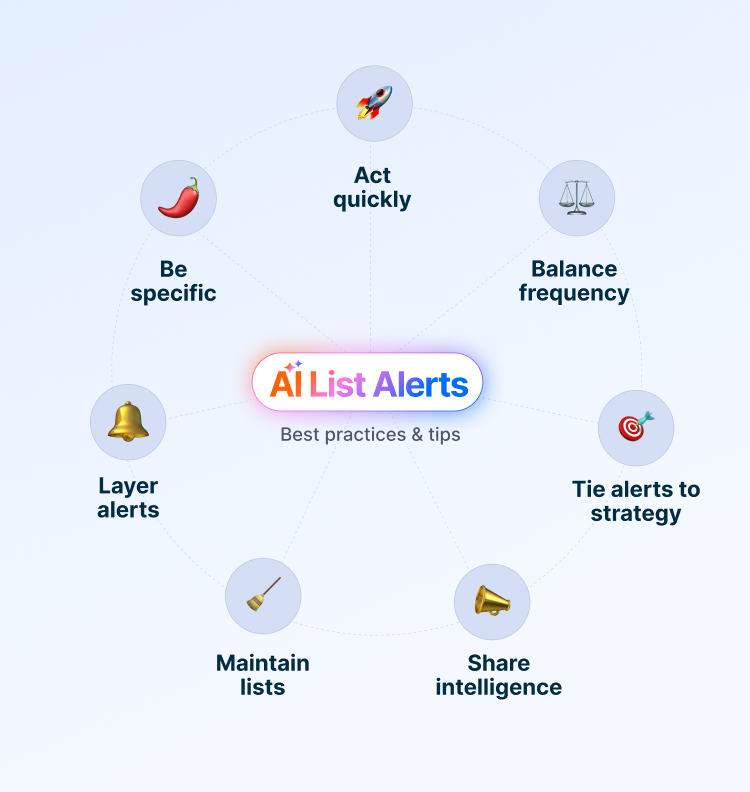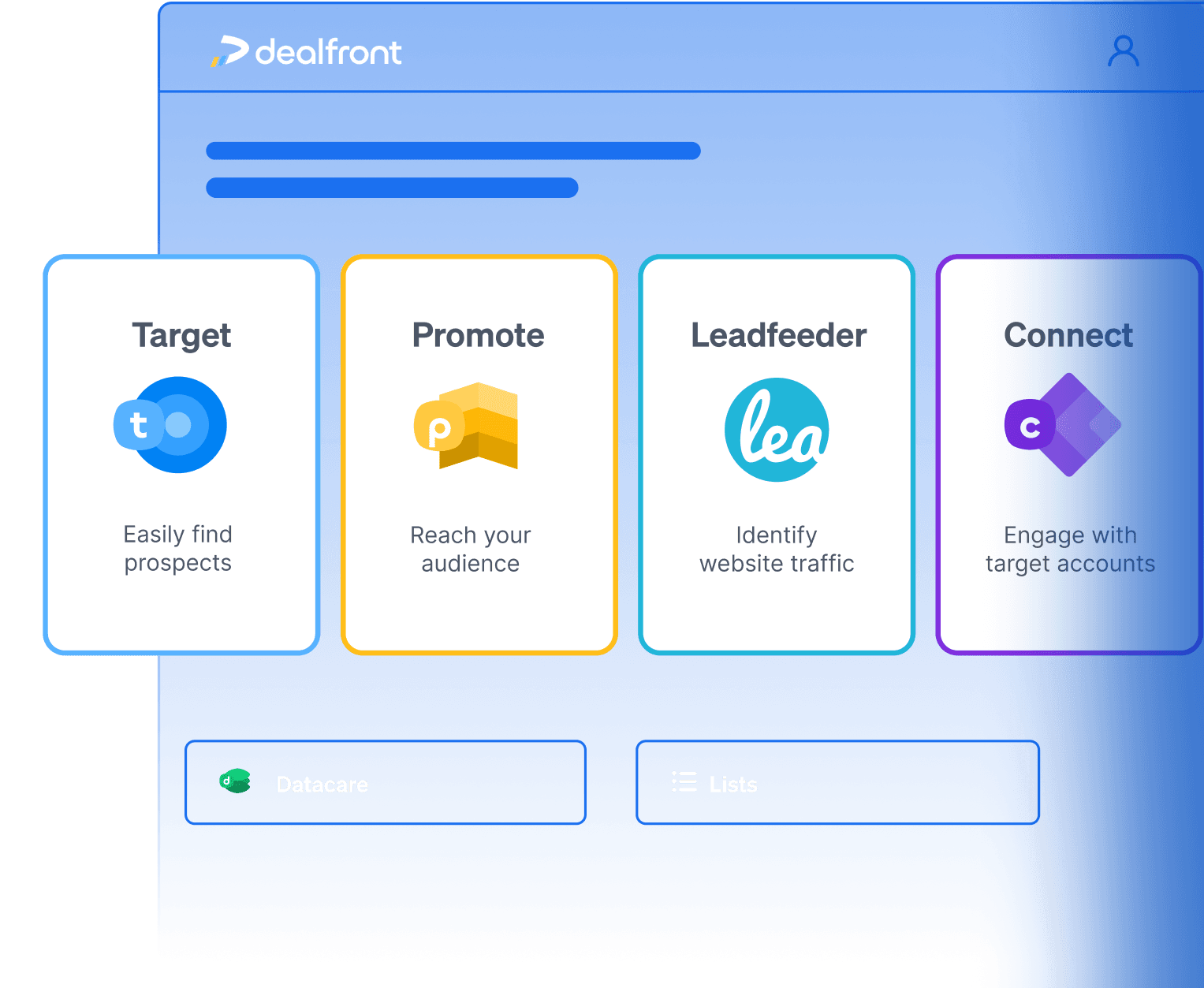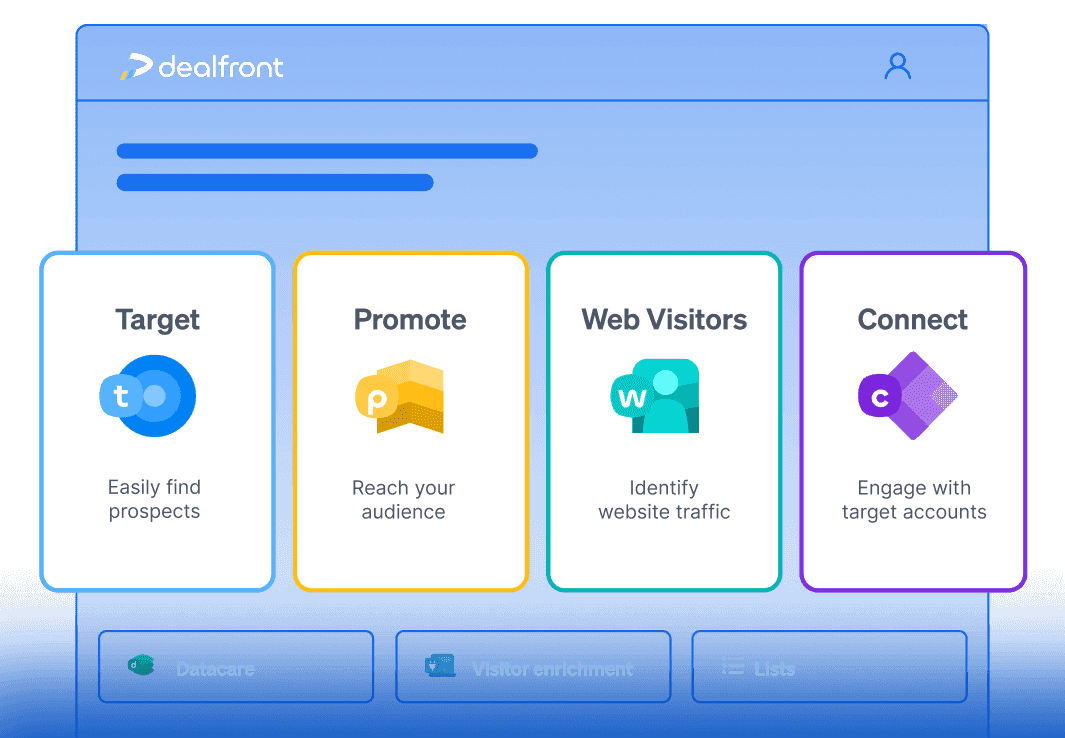How to Stay on Top of Key Account Changes Without Manual Tracking
This play is also available in German.
Expected results
Always-on alerts that surface key company signals straight to your inbox.
Faster, more personalized outreach and campaigns that align with real-time changes.
Stronger sales and marketing alignment through shared, actionable intelligence.

In fast-moving markets, timing is everything. A new executive hire could signal a shift in strategy and new budget authority. A funding round might indicate rapid expansion and upcoming investments. A product launch could open the door to strategic partnerships.
These are the kinds of moments that create windows of opportunity for sales and marketing teams, but spotting them at scale is almost impossible if you rely on manual monitoring. No one has time to track every target account across the news, press releases, and hiring pages.
That’s where AI List Alerts in Dealfront come into play.
AI List Alerts keep you automatically updated on important developments across your saved company lists. Instead of spending hours scanning sources, updates land directly in your inbox, helping your team react quickly and with context.
With AI List Alerts, you can:
Stay informed automatically without manual research.
Personalize campaigns and outreach with timely, relevant context.
Focus on the opportunities that matter, when accounts in your pipeline make a move.
The problem with manual monitoring
For most sales and marketing teams, monitoring every target account for updates is simply not realistic. Salespeople often miss critical shifts, such as executive changes, funding announcements, or strategic hires, because they don’t have the bandwidth to track each account in detail. These missed signals represent lost opportunities to start conversations at precisely the right time.
Marketing teams face a different, but equally time-consuming challenge. To keep campaigns relevant, they spend hours combing through press releases, news feeds, and industry publications. Even then, much of what they find is either outdated by the time it’s discovered or not specific enough to be actionable.
The shared result is a lack of personalization at scale. Without a system to surface timely, account-specific insights, both sales and marketing default to generic messaging. This dilutes their impact, slows their response to opportunities, and ultimately reduces their ability to engage prospects with the right message at the right moment.
The Dealfront advantage: AI List Alerts
AI List Alerts transform account monitoring from a manual, reactive process into an automated, proactive one. Instead of requiring teams to constantly research companies, the system does the heavy lifting by tracking your saved lists in real time and flagging the developments that matter most.
At the core of AI List Alerts is flexibility. You can define what’s important using natural language prompts, for example, “Notify me when a company hires a new VP of Marketing” or “Alert me when companies on my list announce funding.” These prompts allow sales and marketing teams to tailor alerts to their exact needs, rather than being limited to generic categories.
When relevant updates occur, they’re compiled into a digest and delivered directly to your inbox. You decide the cadence, whether daily, weekly, or monthly, so the flow of intelligence matches your team’s working rhythm. Each alert isn’t just a headline; it includes the signal type, a source link for verification, and direct access to the company profile for added context.
The impact is immediate. For sales teams, alerts help them time outreach to coincide with buying signals and organizational changes, ensuring they approach prospects when the chances of engagement are highest. For marketing, alerts inject fresh intelligence into campaigns, enabling them to align messaging with real-world events in their target accounts.
In other words, AI List Alerts don’t just keep you informed, they keep you actionable.
Step-by-Step Workflow
In the video below from Sjoerd’s webinar, you’ll get a quick walkthrough of how to set up and manage AI List Alerts. He takes you through the same steps we outline here, from creating your first alert, to writing prompts, previewing results, and activating updates. By the end of the demo, you’ll see just how simple it is to go from a static company list to an always-on flow of actionable intelligence.

Tip: Notice how Sjoerd uses natural language prompts to define the signals he wants? This is the key to tailoring AI List Alerts to your exact needs.
Step 1 – Open your ‘Company List’ and create an alert
The first step is about setting up your foundation. Begin by opening one of your saved lists in the Companies List app. From there, you’ll see an option to create an alert directly at the top of the page.
Go to any saved list in the Companies tab.
Click Create Alert at the top of your list.
Step 2 – Write a natural language prompt
Now it’s time to tell the system what matters to you. Instead of using rigid filters, AI List Alerts work with natural language. This makes it easy to describe the exact kinds of updates you want to monitor.
Define what updates you want to track.
Example: “Notify me when companies hire a new VP or C-level executive in sales, marketing, or operations.”
Use the provided prompt examples for inspiration.
For marketing: Track product launches or funding news to adapt campaign messaging. For sales: Track executive changes or revenue hires to identify fresh entry points.
Step 3 – Preview your alert
Before activating, it’s important to preview how your alert will work. This ensures you’re capturing the right type of updates and avoiding irrelevant noise.
Click Generate Preview to test your prompt.
Review sample results showing:
The company name
The signal detected
A source link with more details
Refine your prompt if needed until the results align with your use case.
Step 4 – Set recipients and frequency
Once you’re confident in your alert, decide who should receive it and how often. This makes it easy to distribute intelligence across your team and match delivery cadence to your workflows.
Choose who receives the alert (yourself or teammates).
Select how often: daily, weekly, or monthly.
For marketing: Weekly alerts can help prep content calendars or campaign adjustments. For sales: Daily alerts ensure timely follow-ups and outreach.
Step 5 – Save and activate the alert
When your configuration is ready, save the alert to set it live. The system will switch from setup to monitoring mode, and updates will begin to arrive automatically.
Once saved, the Create Alert button changes to Manage Alert.
Alerts are now active and will be delivered to inboxes based on your chosen schedule.
Step 6 – Review and take action
Every alert email is designed to be immediately actionable. Instead of overwhelming you with raw information, updates are distilled into concise summaries with links for deeper exploration.
Alert emails summarize up to five company updates with:
Signal type (e.g., new funding, exec hire).
Source link for verification.
Link to the full company profile or list.
Use these insights to:
Launch personalized campaigns (marketing).
Time outreach around fresh developments (sales).
Step 7 – Manage alerts over time
Finally, keep in mind that alerts are flexible. As priorities evolve, you can adjust prompts, pause alerts, or remove them entirely. This ensures the intelligence you receive always stays aligned with your goals.
Modify prompts anytime to refine focus.
Pause or delete alerts directly from the list.
Unsubscribe via email if an alert is no longer relevant.
Best practices & tips
Like any tool, AI List Alerts are most effective when they’re used thoughtfully. Simply setting up a generic alert and waiting for AI insights isn’t enough; the real power comes from aligning alerts with your team’s strategy and refining them over time. By being deliberate about how you configure and share alerts, you can ensure the intelligence you receive translates directly into measurable outcomes.
Some best practices to keep in mind include:

- 1.
Tie alerts to strategy: Align monitoring with your highest-priority accounts and goals.
- 2.
Be specific: Focus prompts on signals that matter most (funding, leadership changes, partnerships).
- 3.
Balance frequency: Daily for fast-moving sales, weekly for marketing and planning.
- 4.
Share intelligence: Forward alerts across teams to enable coordinated action.
- 5.
Layer alerts: Create separate alerts for exec hires, product launches, and funding, then assign them by team.
- 6.
Act quickly: Signals are perishable. Outreach within days — not weeks — maximizes impact.
- 7.
Maintain lists: Keep account lists clean and updated for the most relevant insights.
What to expect using AI List Alerts
When you integrate AI List Alerts into your workflow, the benefits become clear very quickly. You’re no longer scrambling to discover opportunities after they’ve passed, you’re reacting in real time, with context that makes your engagement sharper and more relevant. Sales teams gain the ability to time their outreach with precision, while marketing teams can inject fresh intelligence into campaigns and creative planning.
The outcomes you can expect typically fall into two categories:
- 1.
Faster reactions - Sales and marketing both benefit from having timely intelligence at their fingertips.
Sales: Reach out when prospects display fresh buying signals.
Marketing: Adjust messaging to align with breaking news.
- 2.
More personalized engagement - Signals also give your team the ability to personalize at scale, making every touchpoint more relevant.
Reference timely updates in outreach and campaigns.
Demonstrate awareness and relevance to prospects.
Steal our free template: AI List Alert prompt examples
One of the strengths of AI List Alerts is the ability to define exactly what you want to track using simple natural language. Instead of setting rigid filters or rules, you can describe the signals in your own words, and the system will do the monitoring for you. This flexibility means different teams, and even individuals within teams, can create alerts tailored to their unique priorities.
Here are some examples to help you get started quickly:
For Marketing teams:
Use alerts to spot signals that help you align campaigns, content, and messaging with what’s happening in your target accounts.
“Notify me when companies in my list launch a new product or feature.”
“Alert me when a company raises a Series A, B, or C round.”
“Tell me when companies expand into new geographic markets.”
“Notify me when target accounts announce new partnerships or collaborations.”
For Sales teams:
Set alerts that uncover buying signals, organizational changes, and new decision-makers.
“Alert me when companies hire a new VP or C-level leader in Sales, Marketing, or Operations.”
“Notify me when companies add a Head of Procurement, IT Director, or Chief Revenue Officer.”
“Tell me when companies open new offices or expand headcount.”
“Alert me when companies announce major contract wins or customer acquisitions.”
For joint Sales & Marketing alignment:
Create shared alerts that deliver insights both teams can use for coordinated action.
“Tell me when any company in my pipeline changes leadership or board members.”
“Notify me when a company receives industry awards or recognition.”
“Alert me when companies mention sustainability initiatives or ESG goals.”
“Tell me when companies adopt new technologies or platforms.”
By starting with prompts like these (and then refining them based on results) you can ensure your alerts deliver highly relevant intelligence. The key is to focus on the kinds of signals that represent movement, change, or opportunity within your target accounts.
Instead of spending hours scanning for updates, your team can rely on AI List Alerts to surface exactly the news you care about, curated, timely, and ready to act on.
Turn insights into action
Ready to grow your pipeline?
GDPR Compliant
Built & Hosted in EU
Deep B2B Data







